The Functional Literacy, Education and Mass Media Survey (FLEMMS) is a household-based nationwide survey conducted every five (5) years in accordance with the Designation of Statistical Activities that will Generate Critical Data for Decision-making of the Government and the Private Sector (Executive Order No. 352 of 1996). The 2024 FLEMMS is the seventh in the series of literacy surveys in the country starting in 1989. It was last conducted in 2019. The FLEMMS presents comprehensive statistics on the latest status of literacy, education, and mass media exposure of Filipinos. it provides a quantitative framework that will serve as basis in the formulation of policies and programs on the improvement of literacy and education status of the population.
The 2024 FLEMMS adopted the revised operational definition and methodology in estimating basic and functional literacy in the Philippines as approved by the Philippine Statistics Authority (PSA) Board through Resolution No. 13, Series of 2024., wherein Basic Literacy is defined as the ability of a person to read and write a simple message in any language or dialect with understanding, and to compute or perform basic mathematical operations; while Functional Literacy is the ability of a person to read, write, compute and comprehend.
CAR ranks second among regions with highest basic literacy rate
In 2024, 90.0% of Filipinos or about 93.07 million individuals 5 years old and over were basically literate. This means that 9 out of 10 Filipinos aged 5 years and over can read, write, and compute.
In the Cordillera Administrative Region (CAR), 92.7% of the estimated 1.7 million individuals 5 years old and over were basically literate, 2.7 percentage points higher than the national rate (Figure 1).
CAR ranked second among the regions with the highest basic literacy rate immediately following Region III (92.8%). BARMM (81.0%) recorded the lowest basic literacy rate among the regions.
Figure 1. Basic Literacy Rate by Region, Philippines: 2024
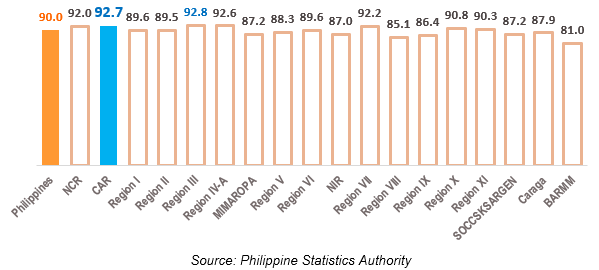
Apayao ranks first among provinces with highest basic literacy rate
By province and highly urbanized city in CAR, Apayao (95.2%) had the highest basic literacy rate in 2024, followed by Benguet (94.9%) and Baguio City (94.3%). The province of Kalinga had the lowest basic literacy rate at 87.0% (Figure 2).
In addition, the provinces of Apayao and Benguet also belonged to the top 5 provinces in the country in 2024 in terms of basic literacy rate, with Apayao ranking first in basic literacy, followed by the province of Benguet.
Figure 2. Basic Literacy Rate by Province/HUC, CAR: 2024
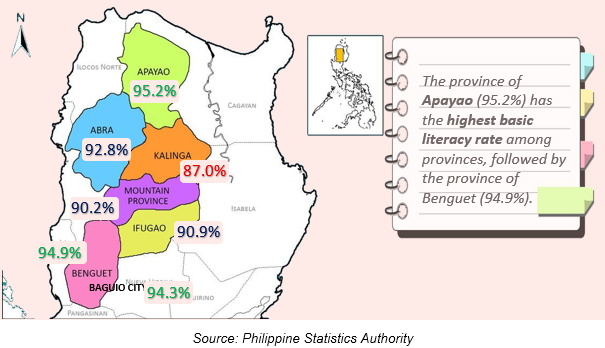
Females dominate the males in terms of basic literacy
In terms of sex, basic literacy rate was higher for female Filipinos with 90.9% compared to the rate of 89.0% among males (Figure 3). This was also observed among individuals 5 years old and over in CAR in 2024, wherein females aged 5 years old and over exhibited a higher basic literacy rate at 93.0% compared to males of the same age range at 92.5%.
Figure 3. Basic Literacy Rate of Population 5 Years Old and Over
by Sex, Philippines and CAR: 2024
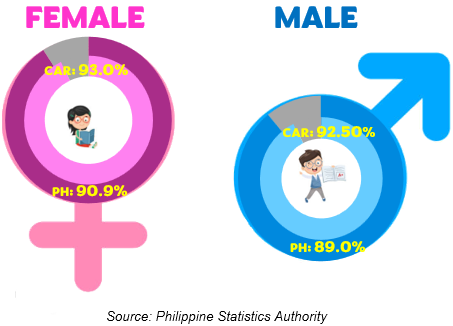
Individuals 20 to 24 years old have highest basic literacy
By age group, basic literacy rate was highest among the age group 20 to 24 years old individuals in CAR with 98.6%, followed by the age group 25 to 29 years old with 98.4%, and 15 to 19 years old with 97.7%.
The age group 60 years old and over or the oldest among the age groups, and 5 to 9 years old or the youngest age group had the lowest basic literacy with 78.3% and 80.0%, respectively (Figure 4).
Figure 4. Basic Literacy Rate of Population 5 Years Old and Over
by Age Group, Both Sexes, CAR: 2024
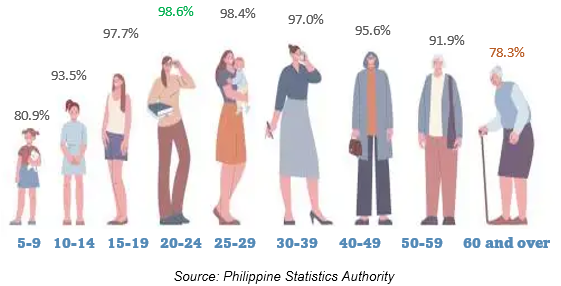
Individuals who reached or completed College have highest basic literacy
In terms of the highest grade completed, individuals in CAR who reached or completed College level or higher recorded the highest basic literacy rate at 98.8%, followed by those who reached or completed Post-Secondary Non-Tertiary (98.4%) and Short-Cycle Tertiary (97.8%) education (Figure 5).
Meanwhile, individuals who had no grade completed had the lowest basic literacy rate at 18.4%.
Figure 5. Basic Literacy Rate of Population 5 Years Old and Over
by Highest Grade Completed, CAR: 2024
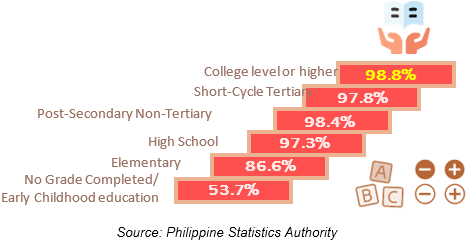
5 out of 100 individuals aged 5 years and over are illiterate
In terms of the level of literacy, about 5.2% or 5 out of 100 individuals aged 5 years and over in the Cordillera region in 2024 were illiterate or one who cannot read and write (Figure 6). On the other hand, about 2.0% or 2 out of 100 individuals aged 5 years and over were of low literacy level or one who can read and write only. To reiterate, 9 out of 10 persons in CAR were basically literate in 2024.
Figure 6. Percentage of Population 5 Years Old and Over
by Level of Literacy, CAR: 2024
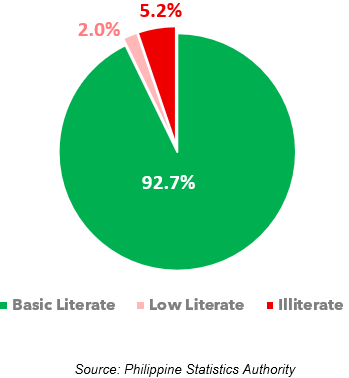
(SGD)
VILLAFE P. ALIBUYOG
Regional Director
Designation Initials Date
CSS AFRBJ 30 June 2025
SS II JRB 03 June 2025
Technical Notes
Basic literacy - the ability of a person to read and write a simple message in any language or dialect with understanding, and to compute or perform basic mathematical operations.
Illiterate - those who cannot read and write.
Low Literate - those who can read and write only.
Basic Literate - those who can read, write and compute.
Highest Grade Completed – the highest grade or year completed in school, college or university.

